Torpedo 53-39 and its modifications
The combined-cycle torpedo 53-38 was an Italian-developed 53-F type of ammunition developed in accordance with the capabilities of the Soviet industry. During the creation of this product, the Soviet designers changed the main machine, and also made some adjustments to other components and assemblies. The resulting torpedo carried an explosive charge weighing 300 kg, could reach speeds up to 44 nodes and attack targets at ranges up to 10 km. The steam-gas torpedo machine could operate in three modes, which made it possible to change the speed and range of the course. Provided shooting from the torpedo tubes of submarines, ships and boats.
In the future, Soviet experts launched work on the modernization of existing weapons. In the course of several additional projects, it was possible to increase the weight of the explosive (53-38U), as well as introduce a non-contact fuse of a new model. In addition, engineers were faced with other goals. One of the main tasks in the modernization of weapons was to increase the speed of a torpedo without losing other characteristics. It was assumed that the result of such a project would be a promising torpedo of the 53 caliber cm with general characteristics at the level of the existing 53-38 and a significantly increased travel speed.
In 1939, two new organizations were created, TsKB-36 and TsKB-39, which now had to deal with all new projects of torpedo weapons. The development of the 53-38 product, including the modernization of the combined-cycle machine, was assigned to TsKB-39. The creation of a new project led by engineers DA. Kokryakov, V.L. Orlov and D.N. Ostrovsky. Subsequently, for the development of a new project, these designers were awarded the Stalin Prize.
The new torpedo with increased speed of movement received the symbol 53-39 - caliber 53 cm, the development of 1939 year. The existing 53-38® torpedo with the 400-kilogram warhead was taken as the basis for it. By changing the design of some of the components and assemblies of this product, it was proposed to raise the basic parameters and thereby fulfill the new requirements. The main means of achieving the goals was the speeding up of the existing steam-gas machine and the increase in the stock of power components.
Forcing the power plant was quite a challenge, because of what the work was delayed. It was possible to complete the design, assemble the experimental products and test them only in 1941 year. Other design tasks turned out to be less complicated and were solved earlier. As a result, despite all the difficulties and timing offsets, all the works were carried out, resulting in the appearance of a new high-speed torpedo, based on existing units.
During the modernization, the torpedo retained the hull with a length of about 7,5 m and a diameter of 53 cm, equipped with a hemispherical head and conical tail fairing. In the tail section there is an X-shaped structure with rudders that covered two propellers mounted on the same axis. The overall layout of the internal units of the torpedo did not change either, however, the dimensions of some parts were adjusted, which resulted in slight changes in the placement of certain units.
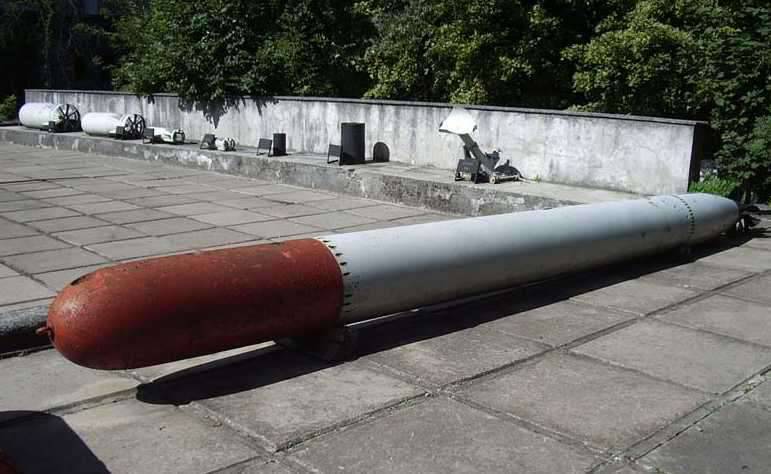
Museum sample 53-39. Photo Navweaps.com
The head part of the corps was still surrendered to the fighting compartment with an explosive charge and fuses. Behind it was a large air tank of increased capacity, behind which water and kerosene tanks were installed, as well as an increased volume. The main machine, including the oil tank, heating apparatus, etc., as well as the control systems were located in the tail section of the hull.
The 53-39 torpedo was created on the basis of the 53-38У product, which had an increased fighting compartment with an 400-kg charge. The new weapon was supposed to differ in increased engine power and, as a consequence, increased consumption of power components. For this reason, the combat compartment of the new torpedo was shortened, and the mass of explosive reduced to 317 kg. The released volume was used for some increase in the air reservoir. Similarly, due to rearrangement of the tail section, the size of the water and kerosene tanks was increased.
The fighting compartment of the new torpedo was smaller and carried a less heavy charge. At the same time, the charge detonation system was fully preserved. In the case of a torpedo, on its upper side, two glasses were provided for the installation of inertia-type contact fuses. Information about the possibility of using non-contact fuses type NVS are missing. The existing detonators were supposed to undermine the warhead when a torpedo collided with a target. Arming was carried out at some distance from the ship or submarine carrier.
The main steam-gas torpedo machine 53-39 was based on the corresponding aggregates of the existing weapon, however, it had a number of important differences. For a long time, TsKB-39 specialists dealt with various issues of improving the engine design, which resulted in an increase in its power to HP 485. For comparison, the maximum power of a torpedo car arr. 1938 g. Did not exceed 310 hp A significant increase in the basic parameters of the power plant made it possible to count on a noticeable increase in speed.
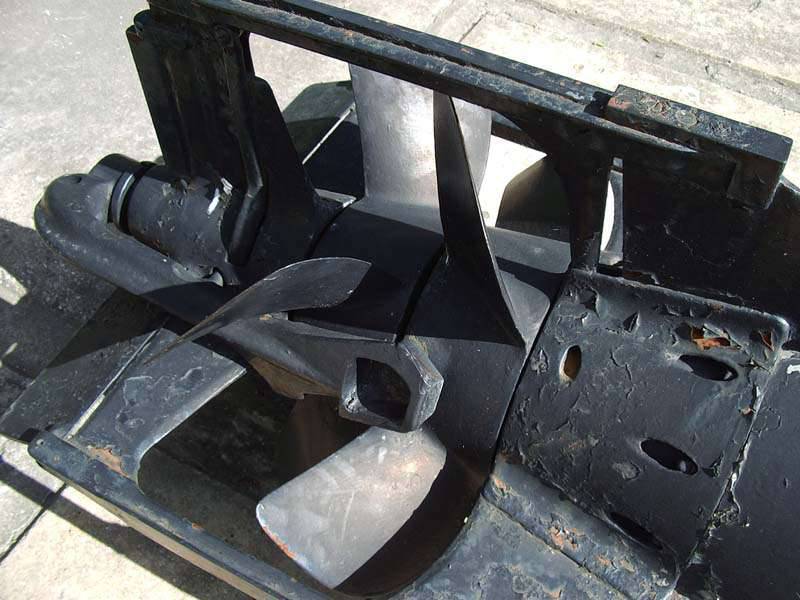
Torpedo propellers. Photo Svsm.org
Forcing the power plant led to an increase in its power, but did not affect the general design features. As before, the gas-steam engine was used based on two cylinders and a crank mechanism. Also, the machine had a heating apparatus, a distribution mechanism and two shafts, with the help of which two coaxial propellers were set in motion. For storage and supply of energy components torpedo received several tanks of high capacity. In addition, to increase the amount of air transported, the pressure in its tank was increased from 190 to 200 atmospheres. Also in the design of the power plant introduced a new oil tank of a larger size.
A significant increase in the power of the main machine made it possible to significantly improve the main characteristics of the torpedo in comparison with the base model. The power plant torpedoes 53-39 could operate in three modes. In the first, she developed the full power of the 485 HP. and could accelerate the torpedo to the 51 node. In this case, the range was only 4 km. On the second mode with power 230 hp the speed was reduced to 39 nodes, and the range increased to 8 km. The maximum range in 10 km was reached in the third mode of the machine with the power of 168 hp. and 34 node speeds.
According to some information, having the ability to work in three modes, from the point of view of practical use, the main machine of the torpedo was dual-mode. Before leaving the ship or submarine at sea, on the base, it was necessary to select the required modes of operation. The possibility of acceleration to the 51 node was preserved in all cases, and the second mode was set by torpedoists and was chosen from two available ones. In this case, in the second mode of the vehicle, the torpedo could overcome 8 or 10 km, depending on the presetting. After going out to sea, the crew of a ship, boat or submarine could choose only from two established modes.
The control systems of the new torpedo were refined based on the experience of testing and operating existing weapons, but retained the overall design. To keep the torpedo on this course, it was proposed to use a hydrostat and so on. Aubrey device based on a gyroscope. While the torpedo was moving, these devices were supposed to track its position, as well as fix deviations from a given course and produce commands for the steering gears. The latter with the help of the rudders shifted and returned the torpedo to the desired course. According to reports, the modernization of existing controls has improved the accuracy of the torpedo. The equipment confidently kept it at a set depth from 1 to 14 m, and the deviation from the set course at the maximum range (10 km) did not exceed 100 m. For the late thirties and early forties, these were good indicators.
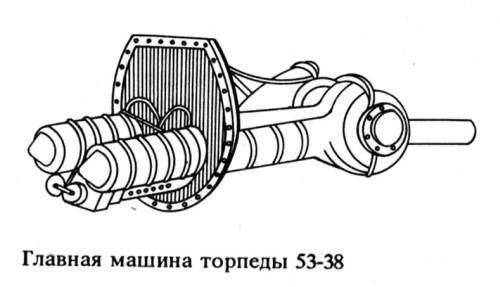
The main machine torpedoes 53-38, which became the basis for the 53-39. Figure Wunderwafe.ru
The design modifications used did not lead to noticeable changes in the dimensions or weight of the torpedo. The dimensions of the 53-39 case remained at the level of the predecessors' parameters: caliber 533 mm and length about 7,5 m. Weight, according to various sources, supplied 1750 or 1800 kg. The torpedo carried an 317 kg of explosive with two fuses.
Work on the project 53-39 were associated with the solution of several very complex problems. As a result, they dragged on for several years. Tests of experienced torpedoes of the new model were carried out only in the 1941 year. By this time, most of the flaws in the 53-38 prototype torpedo and the new 53-39 torpedoes were corrected, which allowed not only to test the performance of the systems, but also to confirm the design characteristics. During the tests, the torpedoes of the new model did manage to reach speeds on the order of the 50-51 knot, but at the same time there was a high fuel consumption, which reduced the cruising range. The maximum cruising range at the level of 10 km at lower speeds was also confirmed by tests.
Tests torpedoes 53-39 fully confirmed the fulfillment of all requirements. Engineers TsKB-39 managed to increase the speed of the weapon without significant losses in other characteristics. In fact, the only disadvantage compared with the base 53-38® was the reduction in the weight of the explosive from 400 to 317 kg. Nevertheless, the high speed of movement fully compensated for the decrease in charge. In addition, calculations have shown that a reduced charge retains the possibility of causing fatal damage to enemy ships. According to the results of tests, which ended by the middle of the 1941 of the year, the new torpedo was put into service. The corresponding document, as well as an order to start the mass production of new weapons, appeared in July of the 41.
It is known that the production of new torpedoes began in 1941, but the exact volumes of their release are unknown. Different sources have different information on this subject. Some argue that torpedoes 53-39 were built in a series of no more than a few dozen, while others speak of several hundred. In addition, there is information about the difficulties at the beginning of mass production, because of which the first serial torpedoes of a new type were transferred the fleet only at the end of 1943. From the same sources it is known that for the remaining period of the Great Patriotic War, Soviet submariners used no more than 18-22 high-speed torpedoes, but could not hit a single target with their help.
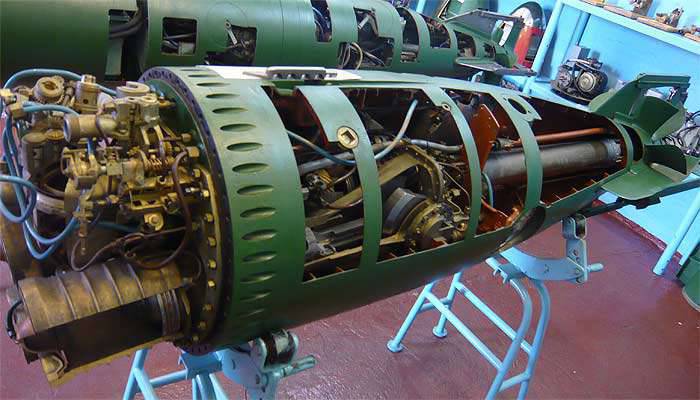
The tail section of the torpedo 53-51 with steam-gas machine. Photo Militaryrussia.ru
Apparently, the 53-39 torpedoes never became the main product of torpedo building, which is why they were significantly inferior in their quantity to other products, primarily 53-38 and 53-38U. As a result, the newer high-speed torpedoes were not widely spread and could not influence the course of military operations on the seas. Despite the emergence of a new weapon with an increased travel speed, the older 533-53 remained the main ammunition for 38-mm torpedo tubes.
According to some sources, even during the war, specialists from the Research Mine Tort and Torpedo Institute (NIMTI) and related organizations, including TsKB-39, started creating new advanced control systems for torpedo weapons. The noticeable results of these works appeared only after the war, and the first torpedo with a renewed control was put into service in the 1949 year.
A serious disadvantage of the so-called. Direct torpedoes are the need for proper aiming before shooting. With the wrong decision of a torpedo triangle, the weapon passes the target or does not even reach it. The aim of the new project was to create a control system capable, in the event of a miss, to give the torpedo a second chance at hitting the target. Such a project was called 53-39PM - “Maneuvering Device”. The designation “Product 112” was also used.
Behind the fighting compartment of such a torpedo, a set of special electrical equipment was installed, which allowed the torpedo to move not only in a straight line, but also along more complex trajectories. Before firing, a torpedo player had to introduce into the maneuvering device a program according to which he could drive a torpedo. At first, the torpedo moved in a straight line along the initial trajectory, and in the case of a slip, it moved to a zigzag movement. At the same time there was a high probability of hitting the target when re-intersecting its course with the course of a torpedo. To further increase the likelihood of successful completion of an attack, the 53-39PM torpedoes should be fired.
In addition to the maneuvering device, the 53-39PM torpedo received an updated steam and gas machine with the HP 460 power. Also some other units and weapon assemblies were modified. All these improvements were associated primarily with new production technologies, which did not have a noticeable effect on the main characteristics of the weapon.
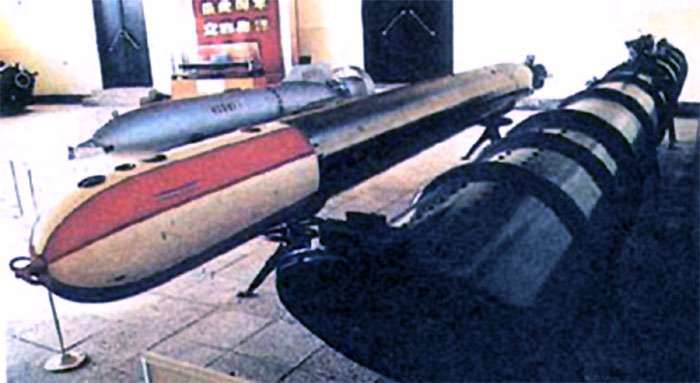
Chinese torpedo Yu-1 and 533-mm torpedo tube. Photo Militaryrussia.ru
After putting the 53-39PM torpedo into service, the development of this weapon continued. Specialists of NIMTI and related organizations have updated some units of this product, as well as introduced new components into its design. The result was the appearance of the 53-51 torpedo, also known as the “592 Product” or “Klyazma”. From the point of view of construction, it was an almost exact copy of the previous 53-39PM, the combat compartment of which was equipped with two different types of fuses. A contact inertial fuse has been preserved, and also a non-contact type NKV has been added (according to other data, NVEM). This device ensured that the warhead would trigger when passing near the target at a distance of 4-5 m.
The 53-39PM and 53-51 torpedoes have been in service with the USSR Navy for some time. Approximately at the end of the fifties or the beginning of the sixties, a gradual abandonment of the existing combined-cycle torpedoes began, resulting in the removal of outdated systems and the subsequent replacement of them with newer and more advanced models. Thus, 53-39PM and 53-51 eventually gave way to new torpedoes on ships and submarines.
Torpedo type 53-51 operated not only in our country. Already in the early fifties, the Soviet Union began selling similar torpedoes to friendly China. Over the next few years, the Chinese fleet had only export torpedoes, unable to acquire domestic ones. According to reports, the production of a copy of the 53-51 product started only in 1966 year. In the Chinese armed forces, this torpedo received the designation Yu-1. In view of the significant lag behind leading countries and their armies, China applied copies of Soviet 53-51 over the next few decades.
In the maximum power mode, the combined-cycle main torpedo machine 53-39 developed the power of the 486 hp. and allowed the weapon to reach speeds up to the 51 node. This made the Soviet torpedo one of the best such weapons in the world. In the early forties, only a few torpedoes in the world could reach speeds of the order of 45-50 nodes, with some of these samples being experimental products. Soviet engineers, it should be noted, could not only create a high-speed torpedo, but also put it in a series. In addition, in the future, the base 53-39 became the basis for several new types of weapons for the fleet. Thus, despite the relatively rare and a few cases of combat use, torpedoes 53-39 can be considered a very successful design, positively affecting the combat capability of the Soviet Navy in the postwar period.
On the materials of the sites:
http://submarine-at-war.ru/
http://wunderwafe.ru/
http://flot.sevastopol.info/
http://navweaps.com/
http://militaryrussia.ru/blog/topic-488.html
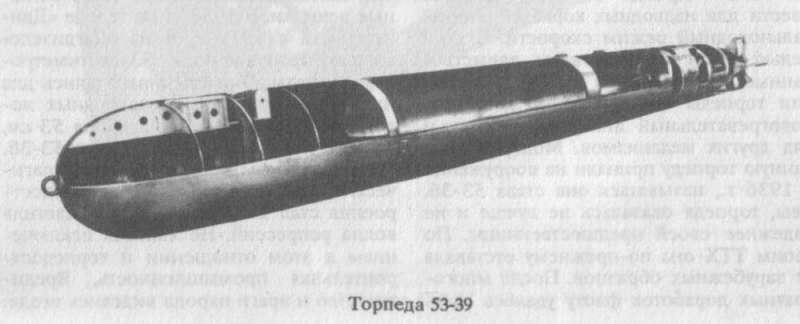
Information